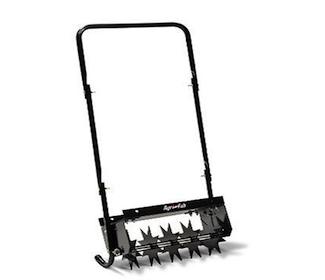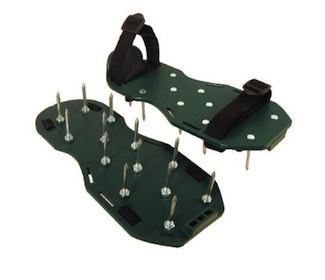Lawn Aeration
Maintaining a green, healthy lawn can sometimes seem like a real uphill battle; grass lawns need almost constant attention and care. To some, it may not be worth all work, time, and money. Others appreciate a lush, green lawn to complement their home's appearance and provide a place for outside activities.
Natural Lawn Care and Your Green Lawn
If you're one of those who loves a green yard and takes pride in its appearance, there are many things you can do to maintain your lawn naturally. There are natural fertilizers such as Milorganite that provide the critical nutrients your lawn needs without the use of toxic chemicals. With proper care, your lawn can be a lush oasis without the need for environmentally unfriendly pesticides and insecticides; a 'green' lawn in the truest sense of the word is a miniature ecosystem that contains a multitude of organisms and healthy grass plants that will naturally crowd out weeds and troublesome insects.
Lawn Aeration: A Green Secret
One important step that is often overlooked by homeowners when caring for their lawn is aeration. Lawn aeration is a 'secret weapon' that does a great deal to make and keep your lawn healthy, naturally.
- Allows oxygen to penetrate the soil to the roots, where it is used for healthy growth.
- Fertilizers and other nutrients important for the grass plant are more easily accessible by the grass' root system.
- Water penetration deep into the soil to the root level is greatly improved.
- 'Thatch', a thick layer of organic debris that can block water and nutrients from entering the soil, is broken up and reduced.
- Hard, compacted soil is loosened up, allowing the grass root systems to grow and spread, and also allows for better absorption of water, oxygen, and nutrients.
Aeration, simply put, involves punching small holes in the lawn's turf. Lawn aeration provides a number of benefits to your lawn, including:
Ways to Aerate Your Lawn
There are several ways to perform the aeration, depending on the size of your lawn, and the amount of physical work you want to put into the project.
Manual Aeration: Manual aerators are typically tools with 2 to 4 hollow metal cylinders that you plunge into the soil with your foot to extract cores, or plugs, of soil. Other types of manual aerators simply use spikes to create holes in the ground. You'll want the type that extracts plugs, which remove soil to allow roots to expand. Manual aerators do a very good job, but are extremely labor and time intensive. Trust me!
Power Aerators: Power aerators are gas-powered machines., available in spiking or coring versions. Again, choose the type that extracts plugs, or cores, of soil. These machines are pushed around the lawn, pulling out plugs. These plugs will break down into the soil after a couple of rains.
Power aerators are commonly available to rent at hardware or rental stores, or at local garden centers. It's common around our neighborhood to pick a Saturday to rent one, and share it around with several neighbors; this divides up the rental cost and makes it quite affordable. Power aerators can be heavy and large, and require some effort to push around. It's important to be careful when using them, and practicing pushing them around so they don't get away from you and crash into trees, your house, or other structures.
Further Options for Lawn Aeration
If you don't want to take the time and physical effort to do the aerating yourself, most lawn care companies provide aeration services, though it's often much more expensive.
There are various 'liquid aerators' on the market that claim to loosen soil and provide aeration-type benefits by simply spraying them on. Use these at your own risk; some may provide some soil improvement, but nothing close to a real, physical aeration.
By aerating your lawn every year or every couple of years, you will be helping to provide your lawn the best environment to grow and thrive.
comments powered by Disqus





































































